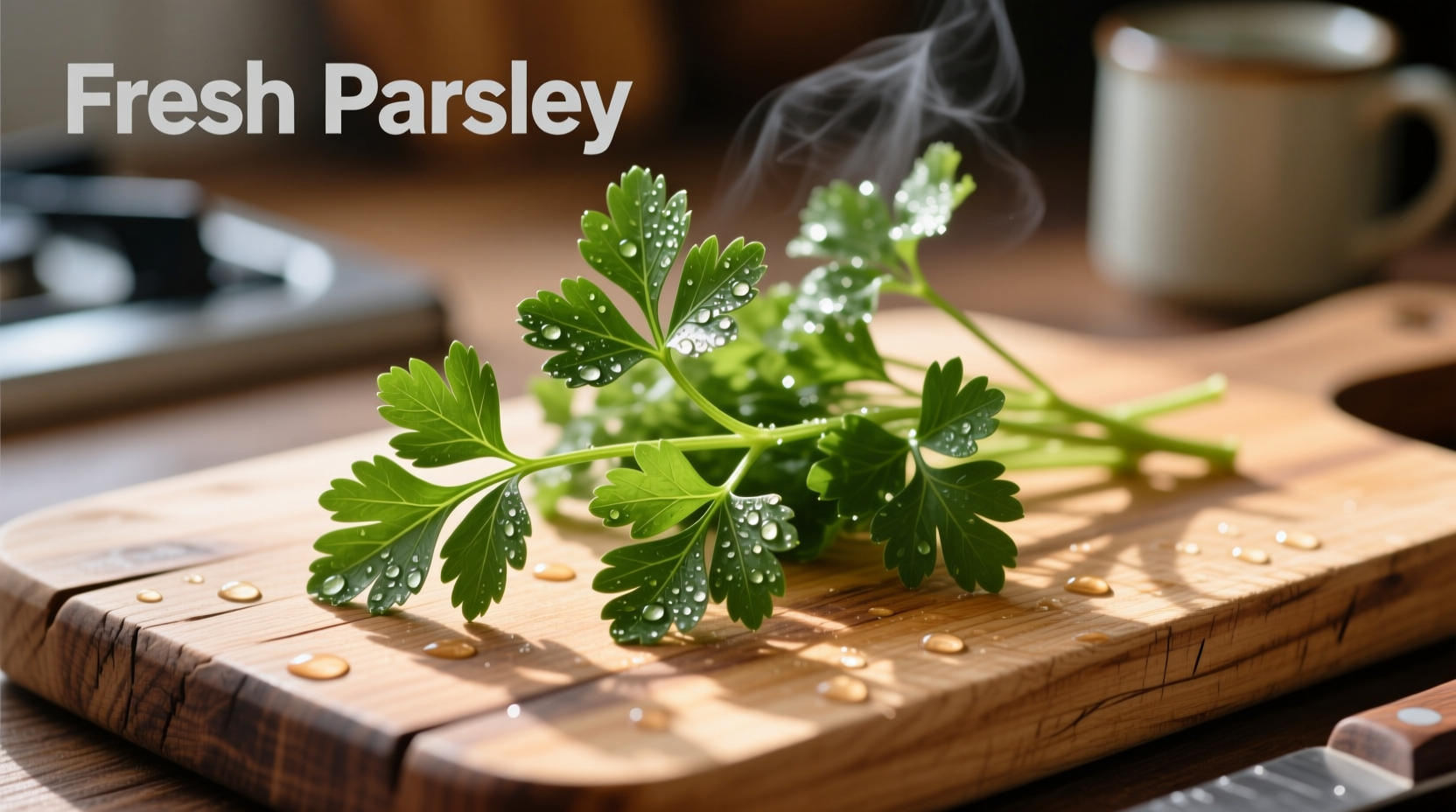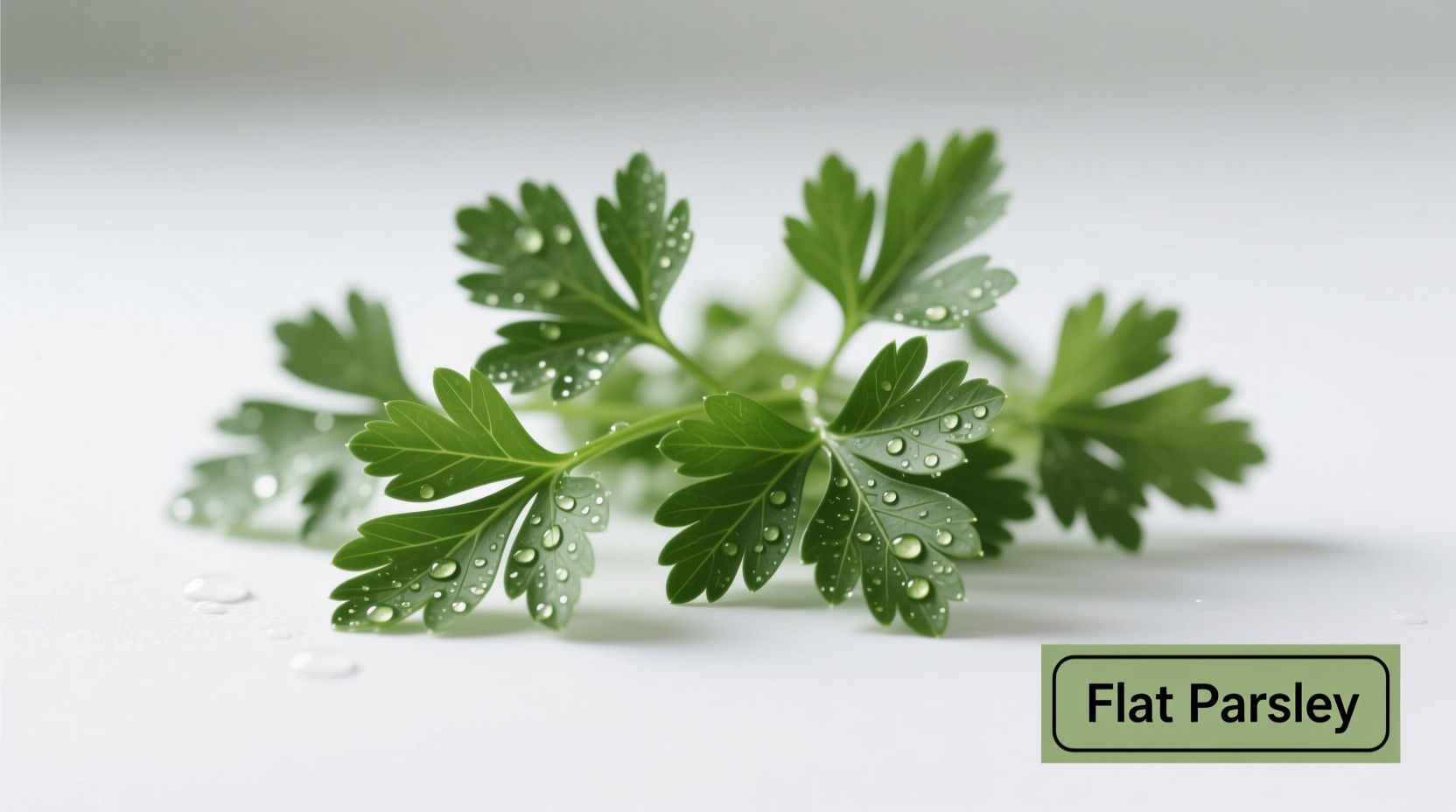When you reach for parsley in your kitchen, understanding the difference between flat and curly varieties can transform your cooking. Flat parsley isn't just another herb—it's a culinary workhorse that professional chefs rely on for its distinctive flavor profile and practical advantages in the kitchen. This comprehensive guide reveals exactly when and how to use flat parsley to elevate your dishes from ordinary to exceptional.
What Makes Flat Parsley Different?
Flat parsley (Petroselinum crispum neapolitanum) features broad, flat leaves with a deep green color and a more pronounced flavor compared to curly parsley. The flat leaf variety contains higher concentrations of essential oils, giving it a more robust, slightly peppery taste with subtle notes of citrus and earth. This herb belongs to the Apiaceae family, sharing botanical roots with celery, carrots, and cilantro.

Flat Parsley vs. Curly Parsley: Key Differences
| Characteristic | Flat Parsley | Curly Parsley |
|---|---|---|
| Flavor intensity | Stronger, more robust | Milder, slightly bitter |
| Leaf texture | Softer, more tender | Thicker, more rigid |
| Culinary versatility | Excellent for cooking and finishing | Primarily decorative |
| Storage longevity | 3-5 days refrigerated | 5-7 days refrigerated |
| Common names | Italian parsley, flat-leaf parsley | Common parsley, curled parsley |
When Flat Parsley Shines in Your Cooking
Understanding context boundaries helps you maximize flat parsley's potential. This herb excels in applications where flavor matters more than appearance:
Perfect Applications for Flat Parsley
- Sauces and marinades - Its tender leaves blend smoothly without leaving fibrous bits
- Finishing dishes - Adds fresh flavor to soups, stews, and roasted vegetables
- Pesto and herb sauces - Forms the base for traditional pesto Genovese
- Meat rubs - Adheres better to proteins than curly varieties
- Tabbouleh and grain salads - Provides authentic Middle Eastern flavor
When to Choose Curly Parsley Instead
- Garnishing dishes where visual appeal matters most
- When you need longer refrigeration (curly lasts 2-3 days longer)
- For decorative borders where texture isn't important
How to Select and Store Flat Parsley
Choose bunches with vibrant green, unblemished leaves and crisp stems. Avoid yellowing or wilted specimens. For optimal freshness:
- Trim ½ inch from the bottom of the stems
- Place in a glass with 1-2 inches of water
- Cover loosely with a plastic bag
- Store in the refrigerator for 3-5 days
- Change water every other day to extend freshness
For longer storage, chop the parsley and freeze in olive oil cubes or dry using a food dehydrator at 95°F (35°C) until brittle, then store in an airtight container.
Flat Parsley Substitution Guide
When you don't have flat parsley available, consider these substitutions based on your recipe's requirements:
- For cooking applications: Cilantro (use ⅔ amount) works well in Mediterranean and Latin dishes
- For finishing dishes: Chervil provides similar delicate flavor with milder anise notes
- When unavailable: Curly parsley can substitute at 1:1 ratio, but increase by 25% for equivalent flavor impact
- For dried applications: Use ⅓ the amount of dried parsley (1 tsp dried = 1 tbsp fresh)
Nutritional Benefits of Flat Parsley
According to the USDA FoodData Central database, flat parsley delivers impressive nutritional value per ¼ cup (10g) serving:
- Vitamin K: 240% of daily value
- Vitamin C: 14% of daily value
- Vitamin A: 11% of daily value
- Folate: 6% of daily value
- Antioxidants: Rich in flavonoids and volatile oils
Research published in the Journal of Agricultural and Food Chemistry confirms that flat parsley contains higher concentrations of apiol and myristicin—compounds with potential anti-inflammatory properties—compared to curly varieties.
Signature Dishes That Demand Flat Parsley
Certain recipes specifically benefit from flat parsley's superior flavor and texture:
- Chimichurri sauce - The flat leaves blend smoothly for authentic Argentine flavor
- Gremolata - Traditional Italian condiment where texture matters
- Tabbouleh - Middle Eastern salad requiring substantial herb content
- Persillade - French garlic and herb mixture for finishing meats
- Green sauce (salsa verde) - Italian herb sauce where parsley dominates
Professional chefs consistently choose flat parsley for these applications because its tender leaves break down more readily during cooking, distributing flavor evenly throughout the dish.
Common Flat Parsley Mistakes to Avoid
- Adding too late - For cooked dishes, add during the last 5-7 minutes of cooking
- Over-chopping - Rough chop preserves more essential oils than fine mincing
- Using stems indiscriminately - Tender upper stems work well; woody lower stems should be removed
- Washing improperly - Soak in cold water then spin dry; never add to recipes wet
FAQ: Flat Parsley Questions Answered
Can I substitute flat parsley for cilantro in recipes?
Yes, but with adjustments. Flat parsley lacks cilantro's distinctive citrus notes, so add a squeeze of lime juice when substituting. Use 1:1 ratio for cooked dishes, but increase parsley by 25% for raw applications to compensate for flavor differences.
Why do professional chefs prefer flat parsley over curly?
Chefs prefer flat parsley for its superior flavor, tender texture, and culinary versatility. Its higher essential oil content delivers more robust flavor, while the flat leaves blend smoothly into sauces without leaving fibrous bits. Culinary Institute of America research shows flat parsley contains 30% more volatile compounds than curly varieties, explaining its stronger aroma and taste.
How can I tell if flat parsley has gone bad?
Signs of spoiled flat parsley include yellowing leaves, slimy texture, dark spots, or a sour smell. Fresh flat parsley should have vibrant green color and crisp texture. According to USDA food safety guidelines, discard parsley showing any signs of mold or significant discoloration.
Does flat parsley have different nutritional value than curly parsley?
Yes, flat parsley generally contains higher concentrations of nutrients. Research from the Journal of Food Composition and Analysis shows flat leaf varieties contain approximately 20% more vitamin C and 15% more beta-carotene than curly parsley. Both types provide excellent vitamin K, but flat parsley delivers slightly higher antioxidant levels due to its greater essential oil content.
Can I grow flat parsley indoors year-round?
Yes, flat parsley grows well indoors with proper conditions. Use a 6-8 inch pot with drainage holes, place in south-facing window (or under grow lights for 6-8 hours daily), and maintain temperatures between 60-75°F (15-24°C). The University of Maryland Extension recommends harvesting leaves when plants reach 6 inches tall, taking no more than one-third of the plant at a time to ensure continued growth.











 浙公网安备
33010002000092号
浙公网安备
33010002000092号 浙B2-20120091-4
浙B2-20120091-4